The OnePlus 3 Review
by Brandon Chester on June 20, 2016 8:00 AM EST- Posted in
- Smartphones
- OnePlus
- OnePlus 3
GPU Performance
GPU performance is one of the areas where Snapdragon 810 actually tended to do quite well. It's also the case that GPUs generally see larger performance gains year over year than CPUs. We already saw how Adreno 530 performs in the LG G5 review, but the device being compared to was the LG G4, which used Snapdragon 808. The OnePlus 3 represents an opportunity to compare a Snapdragon 810 device to its successor using Snapdragon 820.
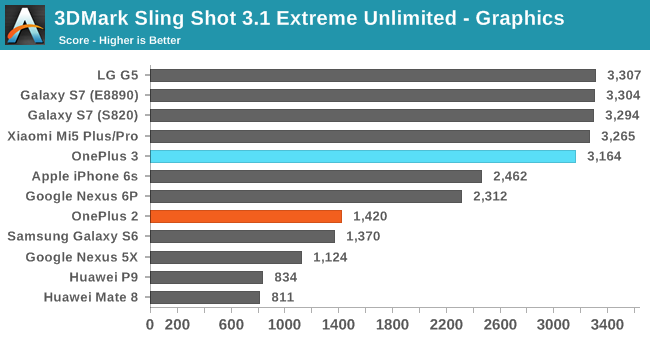
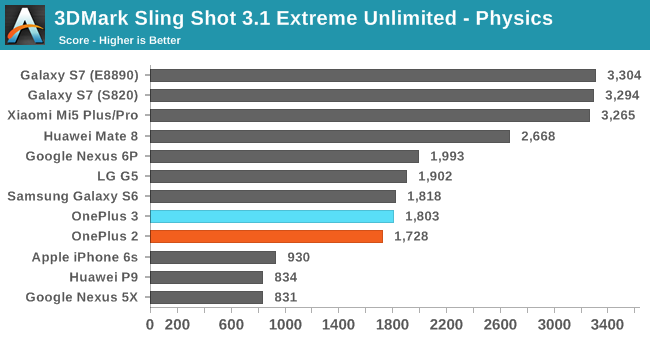
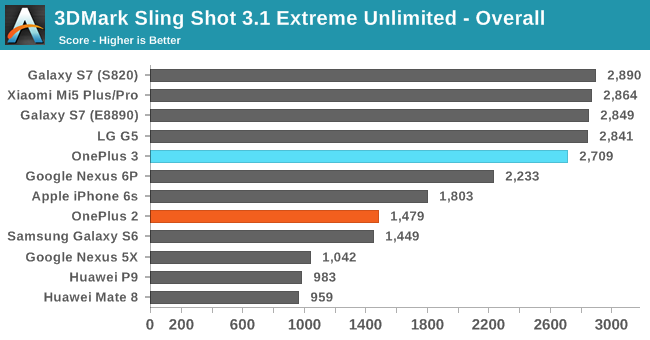
The OnePlus 3 does very well in 3DMark Sling Shot. In both the physics and graphics tests it trails the LG G5 slightly, but the gap isn't anything truly significant. Exynos 8890 is still not something I can compare to until our Galaxy S7 review is posted, but barring that it's clear that Snapdragon 820's Adreno 530 gives the fastest smartphone performance in this test, and when looking at the graphics performance the performance is over two times faster than the OnePlus 2.
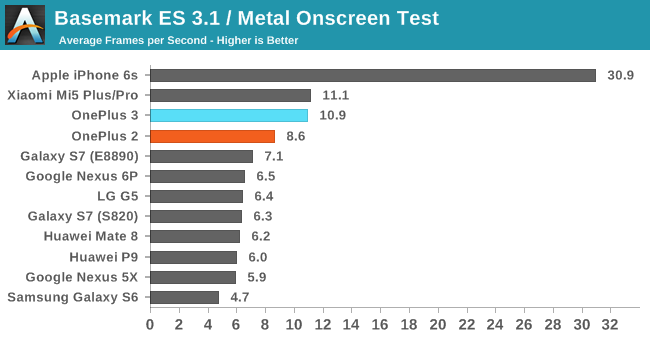
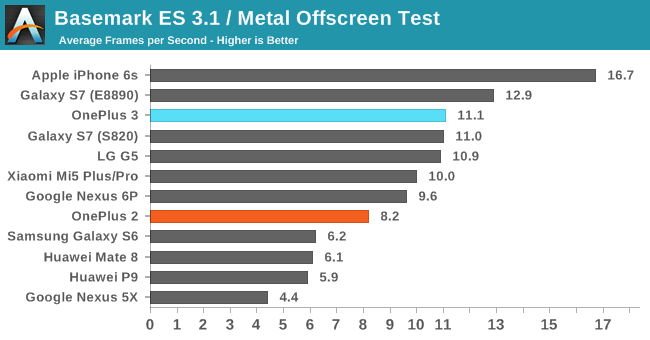
In BaseMark ES 3.1's on screen test the OnePlus 3 manages a significant lead over the LG G5 as a result of its lower resolution. In the off screen 1080p test both phones have essentially the same performance, which is what you'd expect. It looks like Adreno 530 doesn't make the same gains in this test that it does in some others, and it's not clear whether this is just the result of driver optimizations or something about the benchmark that is able to perform batter on other GPU architectures, which could be contributing to the iPhone's lead even in the off screen test.

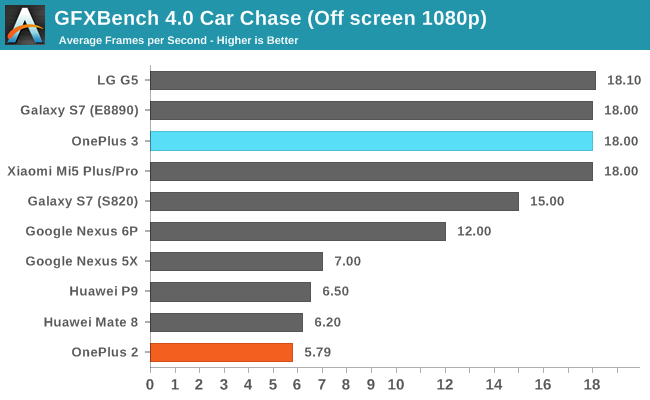
In GFXBench Car Chase the performance of the OnePlus 3 is in line with the LG G5. On screen performance is significantly higher due to the lower resolution display, while off screen performance at 1080p is about the same as the G5 and exactly the same as the on screen result. As far as absolute GPU performance goes, both of our Snapdragon 820 devices are at the top of the chart for absolute performance, and that's good news for anyone playing games or using software that benefits from a powerful mobile GPU.
NAND Performance
The OnePlus 3 moves to a UFS 2.0 NAND solution, which OnePlus claims is three times faster than the eMMC storage used in the OnePlus 2. In more realistic testing you probably won't end up achieving speeds three times faster than the OnePlus 2 since it actually wasn't slow at all by eMMC standards, but there should be a decent uplift in NAND performance nonetheless.
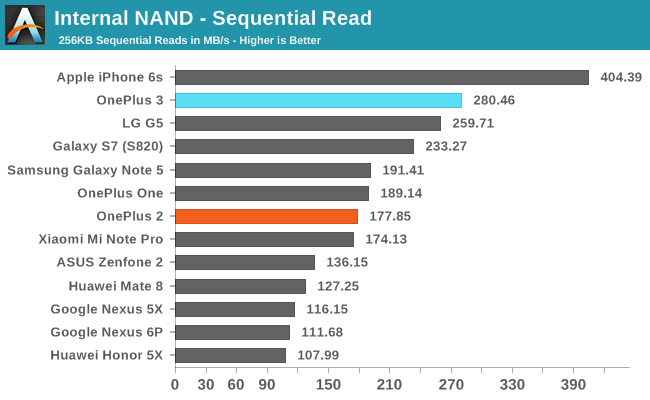
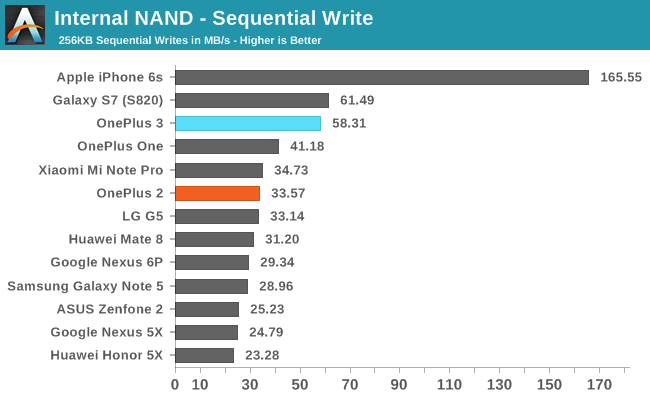
The move to UFS 2.0 brings healthy gains over the OnePlus 2's storage performance, although as I said, the OnePlus 2 didn't perform poorly at all by the standards of eMMC devices. Sequential read and write performance is actually the best that I've measured so far on an Android device. We're still not looking at anything close to what you get for sequential performance on iOS devices, but there are some other factors at play like the fact that the iPhone was a 128GB unit while our Android devices are usually 32GB or 64GB devices. In any case, the OnePlus 3 doesn't present any problems with storage performance, and you certainly won't run into the same issues that you can with budget smartphones at the $200-300 range where the eMMC solutions can be exceptionally slow.










176 Comments
View All Comments
knpk13 - Monday, June 20, 2016 - link
Cyanogenmod is already available for the OP3. Im using it on the OP2 and with a custom kernel which mitigates a lot of issues with the OP2. You guys didn't talk much about development support. OP3 kernel sources and device trees (very rare) were released on day one. I can tune color profiles using kcal by savoca, but I'm not sure how to do that without a colorimeter. So what I'm asking is, can custom Roms and kernel fix the display accuracy?Brandon Chester - Monday, June 20, 2016 - link
No, because the gamut target is incorrect.Buk Lau - Monday, June 20, 2016 - link
Talking about dev support in a review is simply ridiculous. A good product should be good as it is out of the box, dev support is an additional plus, not a solution to its faultsmelgross - Monday, June 20, 2016 - link
You can't personally calibrate these displays because Android has no color management. There is no place for software to put, and use, a color profile for the display. The manufacturer does it, and adds it to the OS with custom code. If a calibrator manufacturer were to offer calibration with their equipment, it would require a special app to be used, only within that app would the profile work. Everything else would remain the same.But, it's worse. Since there is no color management, you need the device to be connected to a computer that does have color management. Then you download an app for your phone, and turn it on. Tou connect your phone to the computer. The app in your computer detects that that app is working when you tell it its on. It then reads from what the app in the phone is doing, and stores that info on your computer. Afterwards, it transfers that info to the special app in your phone. When you open that app in the phone, you can direct it to your picture storage, and view the pictures from within the app. That's about it.
Not very satisfactory? Yup! To fix all of this, Alphabet needs to add color management to Android. But there doesn't seem to be any interest to do this from them, and it does need to be an integrated OS level call.
Lolimaster - Wednesday, June 22, 2016 - link
Thats why for now the only choice for actual display accuracy are:Get Apple products
Samsung Galaxy AMOLED with basic profile
WoodyPWX - Monday, June 20, 2016 - link
My colleague just received the One Plus 3 and I can compare it to my iP6s+ and another colleagues Nexus 5x. OP3 is amazing piece of HW, more beautiful than my iPhone (N5X looks like a toy!) and although it has the same size of the display, it is slimmer, smaller and lighter in total. The touch sensor is blazing fast, just as the charging. UI looks stock (read "fine, I like it"). 64GB and 6GB RAM are enough for everything. I was very surprised by that phone even before I knew how cheap it is! I'm really curious what will be the reaction of other Android manufacturers.polygon_21 - Monday, June 20, 2016 - link
one plus x2 with 5'' screen please.. small handshahmed330 - Monday, June 20, 2016 - link
Where is the GTX1080 review!!!!!!!!!!!!!!!shktr - Monday, June 20, 2016 - link
How can one exaggerate that much about the phone display? Its not even true that its supposedly one of the worst displays around. Been using the phone for about one week now. The screen is fine, ofcourse it can't compete with a galaxy s7 or iphone 6s. Hence, those devices cost double the price. My colleagues also think the screen is fine, great colors and for sure better than the OP1/2.And how come other reviews don't mention how 'bad' the display is? This is the first review which has such complaints about the display.
tipoo - Monday, June 20, 2016 - link
It's not an exaggeration when you have objective measurements to back up your claim.